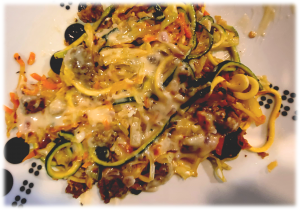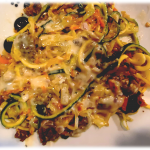
I was looking for something relatively easy to make with some Italian sausage I had in my freezer. I’d made a gnocchi-based dish last week which was excellent and highly recommended, but I wanted to skip the pasta for something more low-carb tonight. This is what I came up with.
The skillet part of the recipe is based on one I found on the Fox and Briar blog which used a pre-packaged slaw mix for the vegetables. Instead, I made my own “slaw,” mixing cabbage, shredded radishes, and other things I had at hand. The skillet on the Fox and Briar blog looks pretty good without the sauce, but I wanted a cheesy sauce for the flavor and depth.
The sauce I selected has a long chain of research behind it. I wanted a cheesy, creamy sauce, which naturally led me to Mornay sauce. There are dozens of “correct” ways to make this sauce. Almost every web site I looked at touted a different method, each of which asserted that theirs was the one-and-only proper way to make a Mornay sauce. They also insisted that even the most trivial variation would doom the sauce to utter failure.
To give you an idea of the variations, some insisted on egg yolks, some omitted them. Some involved shallots or onions, others made no mention of them. Some insisted on using only gruyère cheese, others insisted on a mix that included Parmesan or other cheeses, and all varied on the amount of cheese. Many said to heat the milk before adding it to the pan, others said that was totally wrong and you needed chilled milk. Or room-temperature milk. But whatever temperature the blog mentioned, any other temperature was certain to doom the sauce to failure.
Oh, and whatever you do, don’t taste your sauce while it’s cooking, at least not more than once. The claim is that enzymes in your saliva will doom your sauce.
Sheesh. No wonder people think French sauces are hard to make. One tiny misstep and the whole enterprise is as futile as Gollum’s search for the Ring of Power.
The one thing almost every one of these web sites agreed on was that you had to start by making a roux, or you’d get a “dreadful, flour flavor” in your sauce. But, I already knew from the Beyond Salmon blog that this was false, and that using a beurre manié –a kneaded mix of equal weights of flour and room-temperature butter–was easier, used fewer pans, and was more reliable. See also my prior blog post, To Roux or Not To Roux.
By the way, you can use beurre manié to make gravy, too. After all, gravy is just another kind of sauce. It works better than the flour-water slurry most recipes call for because it tends mix more easily and without lumps. I’ve even used it for pan sauces—see Flo’s Kitchen Blog. Note that she deglazes the pan first, an optional step in the method below.
So, the sauce I’m describing here isn’t a Mornay sauce, since it doesn’t follow any of the rigid—but contradictory—recipes I found online. It is Mornay-like, in that it’s thickened with butter and flour, uses milk for the liquid, and includes grated cheese. But the method I’m using—Option 1 in the method below—is far simpler than any of the rigid formulas.
I wanted to deepen the flavor of my sauce with sautéed shallots and garlic. A few of the online recipes did this, but they almost all involved using one pan to cook the onions and another to make the sauce. One recipe didn’t sauté the onions and garlic, but instead stuck them whole in the sauce while it simmered and then strained them out at the end. In any case, all involved at least one extra dirty dish.
Instead, I’ve used one pan to sauté the onions and garlic and to make the sauce. I just whisk the beurre manié into a simmering mixture of milk and sautéed onions. Easy-peasy.
As an alternative, you could make a roux—using a beurre manié–before adding the milk. Just make the roux by adding the beurre manié to the sautéed onions and garlic that are already in the pan and whisk until it foams but doesn’t brown. I’ve tried both ways and couldn’t tell a difference in taste or texture. Use this second method in case you want to be a purist and make one of the “real” Mornay sauces that include a roux.
Theoretically, you can’t reheat this dish since the cheese in the sauce is likely to separate into a lumpy, stringy mess. However, I was successful reheating it in my microwave by being careful. First, I stirred a bit of milk into the mixture for hydration. Then I set the microwave to “reheat”—power level five on a ten point scale on my microwave—and heated it in 20 second intervals, stirring in between. Once it was warm but not hot, I quit. Doing it this way, it tasted fine, and the sauce survived intact. If I had gone all the way to steamy-hot, I don’t think I would have been as successful.
Here is the recipe– in two parts, one for the sauce and one for the skillet.
Sausage and Slaw Skillet with Mornay Sauce
Ingredients
For the Sauce
- ¼ yellow onion diced or one medium shallot, diced
- 2 garlic cloves minced
- Optional Splash of white wine to deglaze the pan
- 1 TBSP Butter (at room temperature for the beurre manié)
- 2 TBSP Flour for the beurre manié
- 1 TBSP butter or olive oil for the pan
- 1 ½ C milk at room temperature {but straight from the refrigerator works, too, if you’re rushed)
- pinch of nutmeg ()optional)
- ¼ TSP salt
- Pepper to taste
- 4 oz shredded cheese (FYI, 4 oz is 1/2 C) (for example, 1/4 C gruyère and 1/4 C Parmesan)
For the Skillet
- 1 lb Italian sausage –skins removed
- 2 TBSP Olive oil
- ¼ yellow onion diced or one medium shallot, diced
- 2-4 garlic cloves minced
- ½ TSP paprika
- ½ TSP dried oregano
- ¼ head of cabbage thinly sliced
- 1 small zucchini spiralized or thinly sliced with a potato peeler
- 4 radishes shredded
- 2 carrots shredded
- 1 C chopped kale or thinly sliced Brussels sprouts or baby spinach
- Salt and pepper to taste
Instructions
Method for the Sauce
- Make the beurre manié by kneading 1TBSP butter and 2 TBSP flour together in a small bowl, using your fingers or a fork. If the butter isn’t room temperature, you can cut it into a small dice and it will be soft enough to knead in just a few minutes.
- Heat 1 TBSP butter in a sauce pan over medium heat. Add the onions when the butter has melted but before it foams. Stir until soft but not brown, 2-3 minutes. If using oil instead of butter, place a bit of diced onion in the pan while the oil heats. When it sizzles, it’s ready to add the rest of the onions and proceed as above.
- Stir in garlic and cook for an additional 30 seconds
- Optionally, at this point you could deglaze the pan with a splash of wine, making sure to evaporate most or all of the liquid before proceeding.
- Add the 1 ½ C milk and bring to a simmer over medium-low heat.
- Once it’s simmering, whisk in the beurre manié, taking care it dissolves completely.
- Simmer for about ten minutes, continuing to whisk or stir frequently with a rubber spatula to assure that the sauce doesn’t clump or cling to the sides of the pan.
- Remove from heat and stir in the nutmeg (if using), salt, pepper, and cheese. Do not apply heat at this point, as that would tend to separate the cheese. Don't overdo the nutmeg–you don't want your sauce to taste like eggnog!
Method for the Skillet
- You can do this while your stirring the simmering sauce.
- Bring a deep-dish skillet to medium heat. Once it’s hot, add the sausage, breaking it up into bite-size bits. Brown until cooked through, 3-4 minutes. Remove sausage from pan.
- Add olive oil to pan with medium heat. Once it’s hot, add onions with a dash of salt and cook 3-5 minutes, until soft and golden.
- Add the garlic and spices, and cook 30 seconds until fragrant.
- Add the vegetables. Stir and cook until softened and greens are wilted, about five minutes. You might need to do this in batches, depending on the size of your pan and the volume of vegetables.
- Add sausages back into the pan and stir until sausages are re-heated, a minute or two. Remove from heat and add 1 C of the sauce into the sausage and vegetable mixture. Stir until sauce coats the sausage and vegetable mixture. Add more sauce as needed to the desired consistency and taste. Do not apply heat to the sauce, since it will separate the cheese.
Notes


